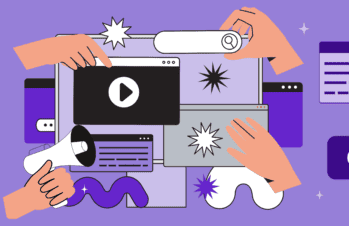The majority of search engine users are inclined to click on one of the top five items appearing on the search engine results page. That’s a sobering thought. You can be the best at what you do, and be the most effective at communicating why that’s so, but none of that matters much if you’re invisible. An effective B2B SEO strategy is no longer optional. Nonetheless, SEO remains widely misunderstood and is often applied in ways that backfire on the user or that simply don’t do much good. Maximum benefit from SEO in preparing web copy depends on the observance of the following ideas:
We’re still living in a monarchy.
By now most of us, possibly all of us, have heard it said that “content is king.” No amount of SEO wizardry will change this. If you have too little content or the wrong content, you will fail. SEO best practices attract attention to your content and can help you distribute it optimally on your website, but they are no substitute for providing sufficient information and presenting it attractively. People searching the web are searching the web for information, and marketers who want to stay in business are in the business of providing that information.
It’s also important to realize that if you are too obvious about spraying keywords around, your unsubtle attempt at self-promotion likely will cost you the trust of potential customers, today’s connected consumer being ever alert for anything that smacks of manipulation. It can also cost you the trust of Google, which has set its algorithms to penalize keyword stuffing. So make sure you maintain substance and follow the following guidelines for securing an audience:
Dedicated pages are key.
Search engines rank individual web pages, not entire websites. So when you come up with a keyword, make sure you have one page on that topic and focus it sharply on that keyword. Your keywords aren’t going to generate traffic unless you have particular pages focused on those topics. Start by thinking about what your readers need to know, and try to provide content that will tell them everything they could reasonably expect on a page dedicated to that topic. Only then should you try to think like Google and view your page in terms of the exact wording you want the search engine to see.
Having the keyword in your title can help guide you through the writing process and make its inclusion in the body of the text feel more natural. That said, remember to consider the reader’s intent before you start creating keywords.
Make sure you’re diligent about keyword research, that you determine which keywords have a high search volume and check the competitiveness level. Webtexttool and Google’s Keyword Planner are helpful in this arena.
Another reason to be very serious about dedicated pages is that if you have multiple pages with the same content, Google could penalize you for it and harm your rankings. This can also happen if your content is on someone else’s website. Remember, you don’t want to be everywhere; you want to be concentrated in one spot and lure the whole world to visit you.
Title tags matter—a lot.
Search engines and visitors both need to see the right things here. A page’s title tag appears in search results and in your browser’s tab, and it’s saved when you bookmark a page. If possible, use your brand name in your title, as this can help visitors recognize you readily. For rankings and emphasis in search results, you should also position important keywords at the beginning. Try for a title that’s attention-getting and that helps describe what the page is about and try to stay within a limit of 60 to 70 characters, including spaces, to remain in control of your message by not having search engines cut off your title.
Meta descriptions are serious business.
Meta descriptions are not crucial for search engine rankings, but they can be decisive in motivating viewers to click when they see their search results. Make sure you use keywords—the search engine results page will highlight the keywords viewers used in their search—make your meta descriptions compelling, and try to keep them around 150 characters.
ALT attributes for images present an opportunity.
A picture might look wonderful to you, but the search engine doesn’t see what you do. It needs to be told what it’s looking at, so what you need to do is give your image a name. Write a brief but very specific description, using keywords if possible. ALT attributes make your images searchable in an image search, which gives you a chance to be noticed beyond a conventional web search.
Internal and external links add relevance.
One of the best things you can do is to link to other pages on your own website. This helps strengthen the keywords for those pages, allows search engine robots and human users to navigate the website, and establishes the relevance of that page for the search engine.
Be sure to use keywords for the anchor text in the actual link. For example, if you are inviting the reader to “contact us today to see how we can meet your supply chain management needs,” you’ll want to link “supply chain management” with your supply chain management page instead of using “contact us today.”
Be sure not to overdo links. Half a dozen per page should be your limit, excluding links necessary for navigation. It’s also important to make sure you set the links to open up in new tabs. Even though the page to which you’re linking—the target page—is on a topic closely related to the page the reader is on, you need to be sure not to divert attention completely from that first page.
Broken links are harmful to SEO, so check your website regularly and repair any breakages that occur.
When using information obtained from other websites, be conscientious about linking to those sources. In addition to being the ethically correct thing to do, this helps you build goodwill and relationships within your industry, which in turn can lead to other people linking to your content—which improves your Google ranking.
Again, be sure to set the links to open in new tabs. You don’t want to direct traffic away from your own website.
Content should be easy on the eye.
This is less important for search engine rankings than it is for helping readers scan the content and see the keywords that interest them. Bold type and bullet points can be helpful if used in moderation, but they can easily become an irritant and a distraction if taken to excess. Paragraphs should be kept short, especially considering the prevalence of mobile devices, but not so short that the message itself becomes choppy and the linkages between ideas unclear. Short sentences tend to encourage attention better than long ones do, but it’s essential never to forget who your audience is. As far as the intellectual level is concerned, one size does not fit all.
Brevity isn’t always good, as analytics can tell you.
Google is friendly toward long-form writing; it’s no accident that blog posts of 600 to 1000 words are so common. If you don’t write much, you’re not telling your readers much, and they will look elsewhere. Time spent on the site, bounce rate, and pages viewed per session are important indicators of how well you’re performing with readers. Insufficient keyword density can cause trouble with all of the above, but so can paucity of material. Don’t go on at length just for the sake of it—readers will notice, and so might Google—but make sure you have something to say and then say it thoroughly.
This is, of course, a partial collection of considerations, and there are numerous books (some of them quite large) and countless websites dedicated to instructing us on optimizing our optimization. However, the basics will go a long way toward helping you rise toward the top five and the opportunities awaiting you and millions of search engine users at that lofty level.







